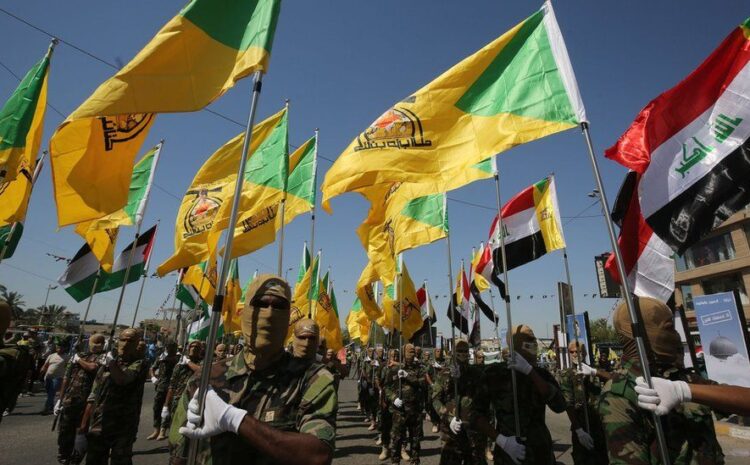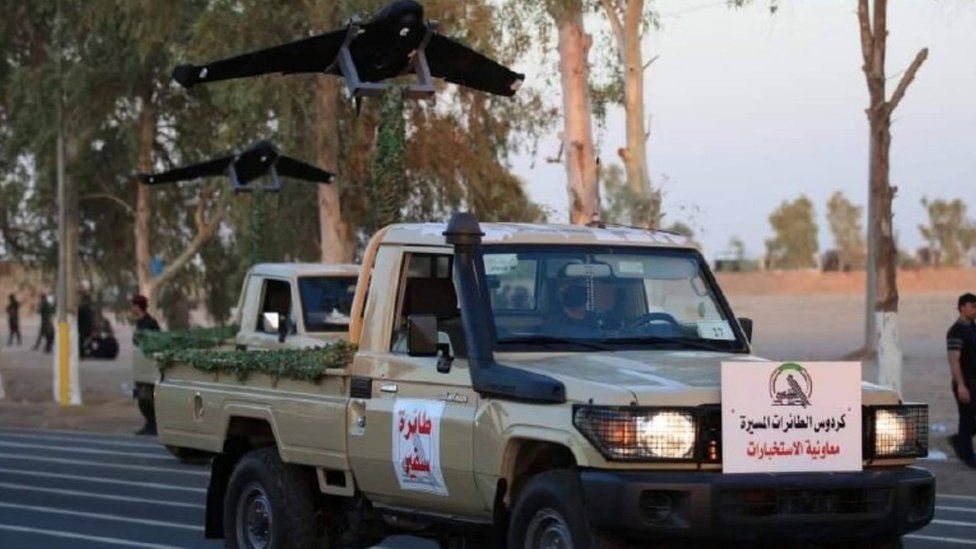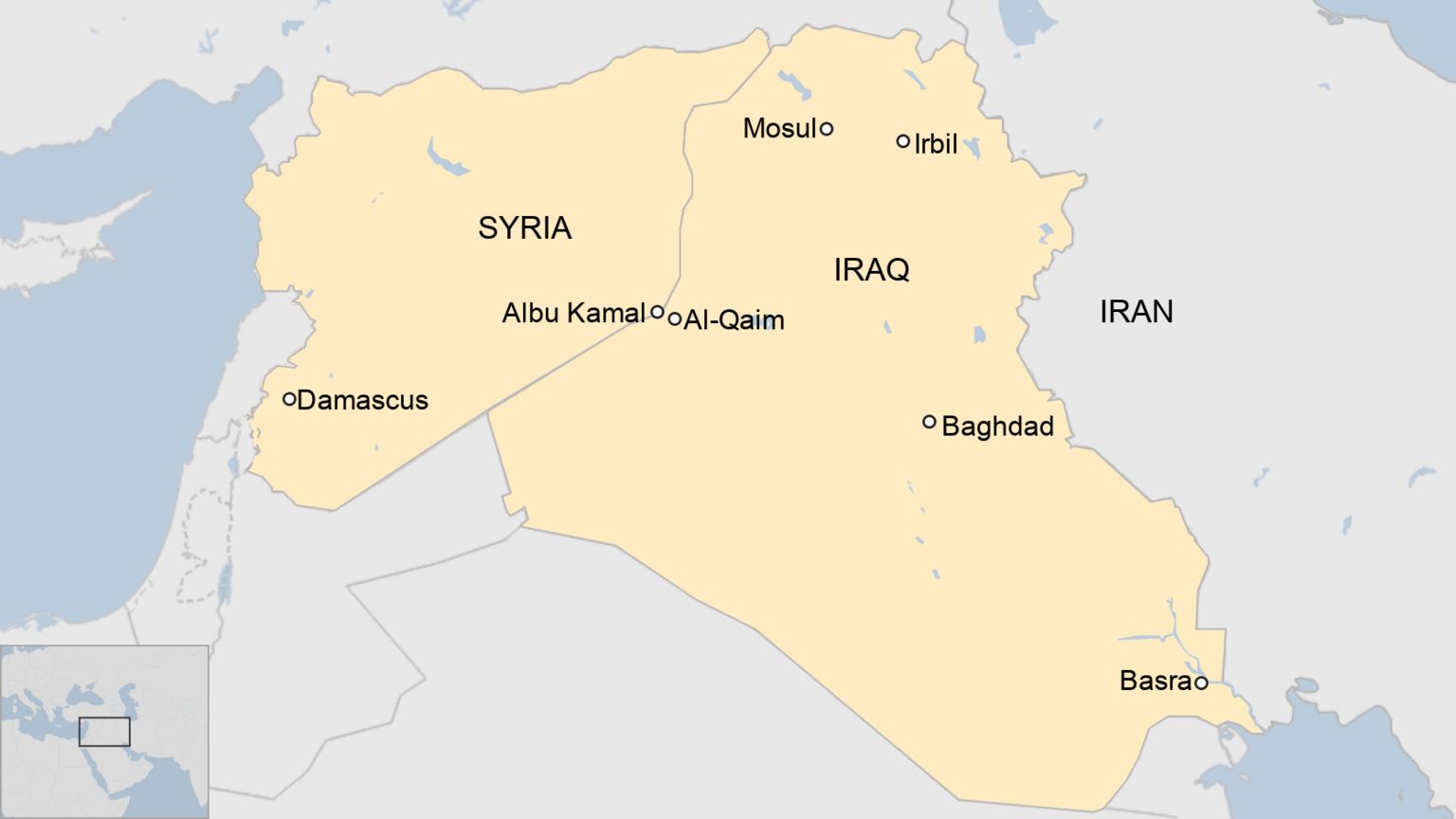
IMAGE COPYRIGHT AFP image caption The US has designated Kataib Hezbollah a terrorist organisation since 2009
A Pentagon spokesman said the strikes targeted “operational and weapons storage facilities” at three locations.
President Biden had been clear he would act to protect US personnel, he added.
A powerful Iraqi militia alliance, the Popular Mobilisation Forces (PMF), said four members of one faction were killed and threatened to retaliate.
About 2,500 US troops are in Iraq as part of a global coalition supporting local security forces in their fight against the jihadist group, Islamic State (IS).
There have been at least five drone attacks against facilities used by US and coalition personnel since April, US officials say. Rockets have also been fired at them and supply convoys have been targeted by improvised explosive devices.
How have the militias responded?
The PMF – a coalition of mostly Iranian-backed Shia militias that was formed in 2014 to fight IS, and was incorporated into the Iraqi Security Forces three years ago – said the strikes killed four fighters carrying out an officially-sanctioned mission to prevent IS militants infiltrating Iraq.
 IMAGE COPYRIGHT REUTERS
IMAGE COPYRIGHT REUTERSIt added that the fighters had “not [been] involved in any activity against the foreign presence in Iraq”, and that the targeted locations did “not include any [weapon] stores or similar, in contrast to the claims made by the US”.
“As such, we denounce and condemn in the strongest terms this sinful attack on our forces… and we affirm that we maintain the legal right to respond to these attacks and hold accountable their perpetrators on Iraqi territory.”
Iraqi military spokesman Maj-Gen Yehia Rasool also condemned the strikes, writing on Twitter that they represented “a blatant and unacceptable violation of Iraqi sovereignty and Iraqi national security”.
He also reiterated Iraq’s “rejection of becoming a field for settling scores” and called for “calm and the avoidance of escalation in all forms”.
Iranian foreign ministry spokesman Saeed Khatibzadeh said the US was “destroying security” in the Middle East and should “refrain from taking emotional steps, creating crises and tensions, and multiplying problems for people in the region”.

Syrian state media reported that a child was killed in a strike near the Syrian border town of Albu Kamal early on Monday, and accused the US of seeking to undermine efforts to improve stability in the area.
The Syrian government has relied heavily on support from Iran’s Revolutionary Guards and Shia militias during the country’s civil war, and they have a significant presence in the border region.
The Syrian Observatory for Human Rights, a UK-based monitoring group, said seven militia fighters were killed in strikes near Albu Kamal.
What did the US target?
Pentagon spokesman John Kirby said the “defensive precision air strikes” that took place early on Monday were intended to “disrupt and deter” drone attacks on US personnel in Iraq.
They targeted facilities at two locations in Syria and one inside Iraq that were used by several Iran-backed groups, including Kataib Hezbollah and Kataib Sayyid al-Shuhada, he added.
US media reported that the strikes – the second round targeting Iran-backed militias ordered by President Biden since he took office in January – were carried out by US Air Force F-15s and F-16s using satellite-guided munitions.
“We took necessary, appropriate, deliberate action that is designed to limit the risk of escalation, but also to send a clear and unambiguous deterrent message,” US Secretary of State Antony Blinken told reporters in Rome.
 IMAGE COPYRIGHT AFP
IMAGE COPYRIGHT AFPThe US has designated Kataib Hezbollah as a foreign terrorist organisation since 2009 and has accused it of carrying out many attacks against US forces in Iraq in recent years.
Its leader, Abu Mahdi al-Muhandis, was killed alongside top Iranian general Qasem Soleimani in a US drone strike in Baghdad last year that then-President Donald Trump ordered following a series of attacks in Iraq that were blamed on Iran-backed groups.
This February, US aircraft bombed a border-control point in Syria used by Kataib Hezbollah and Kataib Sayyid al-Shuhada in response to a rocket attack on a US-led coalition airbase in Irbil that killed one Filipino civilian contractor and wounded six other people. The attack was claimed by a group widely seen as a front for Kataib Hezbollah and other militias.
Monday’s strikes come as Iran and world powers attempt to revive the 2015 nuclear deal.
The agreement has been close to collapse since 2018, when Mr Trump abandoned it and reinstated sanctions that have crippled the Iranian economy. Iran retaliated by gradually breaching agreed limits on its nuclear activities.
Mr Biden wants to rejoin the deal, but he says Iran must return to compliance before the sanctions are lifted. Iran insists that he must lift the sanctions first.
